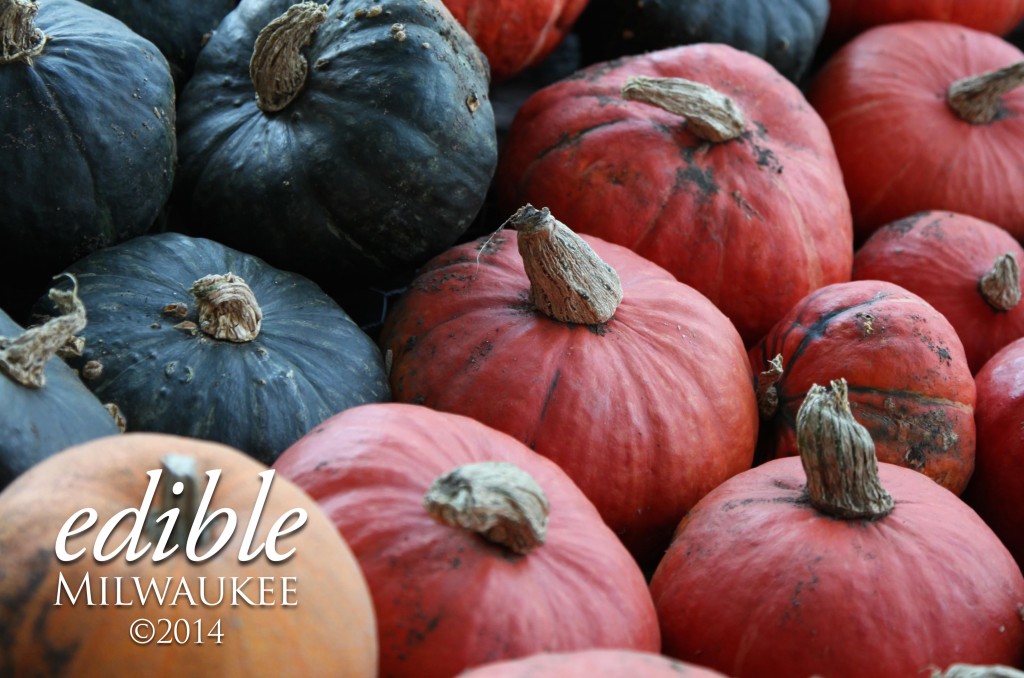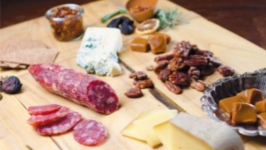Pumpkins: Expand Kids' Palates
Heirloom, lesser-known varieties of pumpkins offer new tastes and hues
Red Fish, Blue Fish. Green Eggs and Ham. Dr. Seuss had it right when it came to teaching us about the different colors and varieties our food can be. If only he hadn’t stopped when it came to fruits and veggies. We always hear about the red tomato, green bean—but where are the orange tomatoes and purple beans?
There are many reasons why certain shades and shapes of vegetables have risen to supreme popularity while their counterparts are left in the dirt. Because of qualities prized by large-scale producers and industrial agriculture, some types of produce have been bred and selected for flavor, others for maximum productivity and shelf life—while others have strange tales of ascent to popularity. Take the carrot for example. Until the late 16th century, purple carrots were the norm in Western Europe. Today’s popular orange varieties were originally derived from red, yellow and white strands. While most horticulturists agree that these “new” orange varieties began to be cultivated by Dutch farmers due to superior sweetness and fleshiness over their purple counterparts, there are also a few stories claiming orange carrots gained popularity in the Netherlands around this time in homage to a string of Dutch rulers named William of Orange.
Whatever the case, it is an unfortunate side effect of this lack of veggie variance that most children are taught to view produce varieties so narrowly. From a young age we learn lettuce is green. Corn is yellow. Flashcards often depict the word red with a tomato, and I highly doubt there is a single rabbit in a picture book eating purple carrots. When youth (and adults!) keep to these limited veggie color notions, and never try produce colors and varieties outside the norm, they miss a whole spectrum of flavor and texture, not to mention local, varieties. Think for a minute about only ever eating red apples. If this were the case, one would never experience the pleasant, sour flavor of a green Granny Smith (perfect for pies), or the crisp texture of the green- and yellow-marbled apple named after our beloved city, the Milwaukee Apple.
When raising a “Good Eater,” we value introducing children to numerous types of vegetables. Why not also to a number of colors and flavors? As we nurture the next generation of eaters and local food supporters, teaching them to appreciate and enjoy all shades of rainbow produce not only encourages youth to be adventurous eaters, but lends itself to education about biodiversity. While eating a salad of heirloom tomatoes, parents or teachers can lead conversations about growing varieties of produce that are best suited for our region’s conditions. Teaching youth to appreciate the color and flavor of food grown locally—now that’s raising a good eater.
This harvest season we challenge you and your family to begin exploring the colorful world of vegetables, starting with a symbol of fall, and a perfect way to smash the veggie color barrier: the pumpkin! In addition to popular orange hues, pumpkins can be yellow, white, green and even blue. They can be large and smooth, or small and covered in bumps. While grocery stores are starting to offer more in terms of produce options, most pumpkins these days are bred and sold for carving jack-o-lanterns, not eating! Even the ones labeled as pie pumpkins in stores are void of much true pumpkin flavor. The best place to find true variety is at your local farmers market. Browse the booths for unique colors and textures, and talk to your farmers about their favorites.
Below is a list of a few of our favorite colorful and edible pumpkins to look for this fall.
Marina Di Chioggia – While warty and green on the outside, the inner flesh of this Italian variety could not be more delicate. Perfect for making pumpkin ravioli, as it is not too sweet.
Long Island Cheese – Long and flat like a wheel of cheese, this tan heirloom variety is great for making pies or pumpkin desserts!
Long Pie Pumpkin – This heirloom variety is the best for all-around cooking! From pies to savory dishes like pumpkin soup or curries, the flesh is virtually stringless, smooth and bright orange. Also known as Nantucket Pie pumpkin.
Kakai – Beneath the black-striped flesh of this unique pumpkin are large, hull-less seeds—perfect for roasting. In addition to sprinkling with salt and pepper, try mixing up your roasted pumpkin recipe this year with these variations: Herbed Parmesan: Garlic powder, chopped dried herbs (rosemary, thyme and basil work well) and finely grated parmesan cheese. Cinnamon Sugar: Cinnamon, brown sugar (or honey), butter, nutmeg and salt. Asian: Soy sauce (or tamari), garlic powder, fresh or ground ginger, and sesame oil.
Follow this recipe for any of the above pumpkin seed flavors:
1. Preheat oven to 350°F.
2. Scoop out the inside of your pumpkin, and separate seeds from pulp. Place seeds and pulp into a large bowl full of water. Massage the seeds and pulp to separate/loosen the stringy pulp from the seeds. The pulp will sink to the bottom while the seeds float. Don’t worry if there’s a little pulp left on the seeds when you roast them—it only adds flavor. Scooping and separating the seeds is a fun step for kids!
3. In a bowl, toss the seeds with selected oil, coating thoroughly. Add salt and seasonings.
4. Spread seeds evenly in one layer across a greased baking sheet.
5. Bake for 30 minutes, or until the seeds are golden brown and start to smell divine. Stir the seeds every so often while they’re baking, so they toast evenly.
Straight from the Farmer’s Mouth: Favorite colorful pumpkins and what to do with ‘em!
Amy Wallner – Amy’s Acre – Caledonia, WI
Variety: Galeux D’Eysines
Why: You can use a knife to write words on young pumpkins and as they mature, it heals over and scars your message on it!
Cooking Tips: Puree until super smooth and use it in a celeriac, ginger & coconut cream soup. I roast it until the ends get carmelized for extra sweetness.
Alissa More – Wild Ridge Farm – Fredonia, WI
Variety: Musque de Provence
Why: It’s gorgeous! They have this beautiful mahogany color that looks almost like wood-grain, and they keep turning a deeper shade even off the vine. Cooking Tips: It works well as a soup pumpkin; you can actually pull off that trick of cooking it, scooping out the flesh, making the soup and putting it back inside the shell.
Heather Hall – Wellspring Organic Farm – West Bend, WI
Variety: Crown Pumpkin
Why: This blue/green-hued beauty is easy on the eyes, delicious, and stores incredibly well.
Cooking Tips: The flesh is a vibrant orange color and has the most velvety texture. I leave the skin on when roasting because I am too lazy to peel it, and it softens up enough to eat. A favorite fall breakfast is oatmeal or quinoa with chunks of roasted pumpkin, cinnamon, ginger, coconut oil, and honey. Sometimes I get real crazy and blend roasted pumpkin into my smoothies to make them extra smooth.






